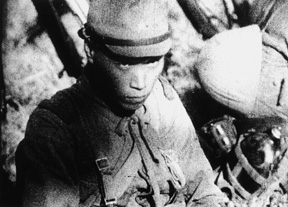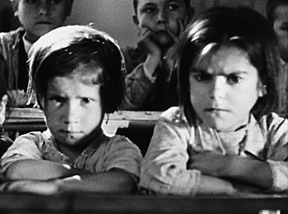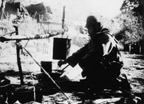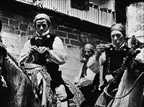Fighting Soldiers
(Tatakau heitai) JAPAN / 1939 / Japanese / B&W / 16mm / 66 min
JAPAN / 1939 / Japanese / B&W / 16mm / 66 min
Director, Editing: Kamei Fumio
Photography: Miki Shigeru
Sound: Kanayama Kinjiro
Location Sound: Fujii Shinichi
Music: Koseki Yuji
Producer: Matsuzaki Keiji
Production Company: Culture Films Department, Toho
Source: Kawakita Memorial Film Institute
Born in 1908, Kamei Fumio studied in the Soviet Union. He edited Shanghai (1938) at Toho’s Cultural Films Department, and directed Fighting Soldiers upon commission from the Japanese Ministry of the Army, only for it to be banned. In 1941 he was arrested and jailed under Japan’s wartime Peace Preservation Law. In 1946, he made A Japanese Tragedy to examine the war responsibility of the emperor, but the film was banned by the Occupation. He made films from an anti-war, anti-nuke, and anti-discrimination position until his death in 1986. YIDFF held his retrospective in 2001.
Land Without Bread
Las Hurdes: Tierra Sin Pan SPAIN / 1933–37 / English / B&W / 16mm / 27 min
SPAIN / 1933–37 / English / B&W / 16mm / 27 min
Director, Editing: Luis Buñuel
Commentary: Luis Buñuel, Pierre Unik, Julio Acín
Photography: Eli Lotar
Narration: Abel Jacquin
Producers: Ramón Acín, Luis Buñuel
Source: Planet Bibliothèque de Cinema
Born 1900 in Spain, died 1983 in Mexico. Made surrealist films such as An Andalusian Dog (1929) and The Golden Age (1930) early in his career. Luis Buñuel made films of a wide variety of genres across three continents including Los Olividados (1950), The Diary of a Chambermaid (1964), and The Discreet Charm of the Bourgeoisie (1972). Land Without Bread was his third film and only documentary. It was originally completed as a silent film but was banned by the Spanish government and remade in France with a French sound version in 1937.

 Fighting Soldiers and Land Without Bread, two classics of world cinema made around the same time, reveal how even the freshest issues of documentary ethics run back to the earliest days of nonfiction filmmaking. Kamei and Buñuel have different targets of critique—imperial aspirations for the former and bourgeois sensibilities for the latter. At the same time, both directors put different spins on the same techniques, from staging and reenactment to the apparent abuse of animals.
Fighting Soldiers and Land Without Bread, two classics of world cinema made around the same time, reveal how even the freshest issues of documentary ethics run back to the earliest days of nonfiction filmmaking. Kamei and Buñuel have different targets of critique—imperial aspirations for the former and bourgeois sensibilities for the latter. At the same time, both directors put different spins on the same techniques, from staging and reenactment to the apparent abuse of animals.
